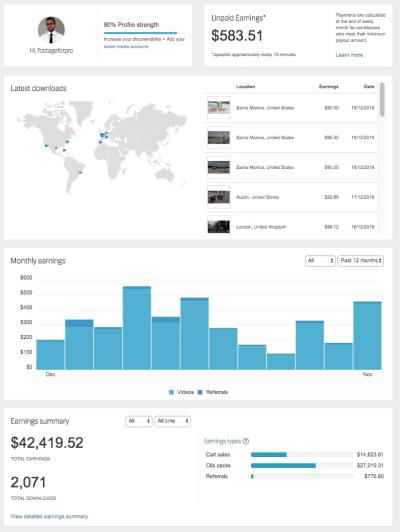Ever wondered how those stunning images on websites, blogs, or marketing materials are so easily accessible? That’s where stock photography websites come into play. These platforms offer a vast library of images, illustrations, and videos that anyone can license and use. They’re like a giant photo marketplace, making it simple for businesses, designers, and content creators to find the perfect visual without the hassle of photoshoots or hiring photographers. Whether you’re looking for professional portraits, scenic landscapes, or quirky icons, stock photo sites are the go-to resource for quick, affordable, and diverse visual content.
Popular Types of Stock Image Platforms
Not all stock photography websites are the same. They come in different flavors, each catering to specific needs or audiences. Here are some of the most common types:
- Royalty-Free Platforms: These sites let you purchase images with a one-time fee, and you can use the images multiple times without paying extra. Examples include Shutterstock, iStock, and Adobe Stock.
- Rights-Managed Platforms: Here, licensing is more specific. You pay based on how, where, and for how long you use the image. These are often preferred for high-end commercial projects where licensing needs to be tightly controlled.
- Microstock Sites: These platforms focus on affordable, high-volume images. They usually have a lower price point, making them perfect for small businesses or personal projects. Think of sites like Shutterstock and Dreamstime.
- Specialized Platforms: Some sites focus on niche content, such as medical images, vintage photos, or creative illustrations. For example, Getty Images offers premium and exclusive content, while platforms like 123RF provide a broad range of general images.
Choosing the right type of platform depends on your specific needs — whether you want unlimited use, exclusive rights, or budget-friendly options. Understanding these differences helps you find the perfect fit for your project and ensures you’re using images legally and ethically.
What Is a Stock Photo Website
If you’ve ever searched for images online to use in your projects—whether it’s a blog post, a marketing campaign, or a presentation—you might have come across websites like Shutterstock. But what exactly is a stock photo website? Think of it as a digital marketplace or a huge library filled with images, illustrations, videos, and sometimes music, that are ready for you to use, often for a fee or sometimes for free.
These websites serve as a bridge between photographers, designers, artists, and businesses or individuals looking for high-quality visuals. Photographers upload their work, and the platform organizes, categorizes, and makes it accessible to users around the world. Instead of hiring a photographer or creating images from scratch, users can simply browse, purchase, and download images that fit their needs.
One of the main advantages of stock photo websites is the wide variety of images available. Whether you need a picture of a smiling team in a meeting, a beautiful landscape, or abstract graphics, you’re likely to find it somewhere on these platforms. They’re especially popular among marketers, bloggers, designers, and small business owners who want professional-looking visuals without the high costs of custom photography.
Another key aspect is licensing. When you download an image from a stock photo site, you’re agreeing to specific terms of use, often called a license. These licenses ensure that the photographers get paid and that users understand how they can legally use the images—whether for commercial projects, personal use, or editorial purposes. It’s important to read and follow these licensing agreements to avoid legal issues down the line.
In summary, a stock photo website is a digital hub offering a vast collection of ready-to-use images, making it easier and more affordable for anyone to access professional visuals for any project.
Features Commonly Found on Stock Photography Sites
If you’ve ever browsed a stock photo website, you’ve probably noticed that they come packed with features designed to make your search easier and your experience better. Here are some of the most common features you’ll find:
- Advanced Search Filters: These allow you to narrow down your options based on criteria like orientation (landscape or portrait), color schemes, image size, type (photo, vector, illustration), and even specific themes or subjects.
- High-Resolution Downloads: Most sites offer images in high resolution, ensuring they look great whether you’re using them on a small flyer or a giant billboard.
- Collections and Curated Galleries: To help you find inspiration or specific styles, many sites organize images into collections or curated galleries based on trends, seasons, or themes.
- Royalty-Free Licensing Options: Many platforms offer royalty-free images, meaning you pay once and can use the image multiple times without additional fees, within the license terms.
- Subscription Plans and Pay-Per-Download: You can choose how to access images—either through monthly subscriptions for a set number of downloads or by paying for individual images.
- Preview and Watermarking: Before purchasing, you can usually preview images at a lower resolution or with a watermark to see how they’ll look in your project.
- Contributor Portals: For photographers and artists, most sites provide a way to upload and manage their work, often with dashboards to track downloads and earnings.
- Model and Property Releases: Some images include legal releases for models or property, which is essential for commercial use, especially in advertising or branding.
All these features work together to make stock photography sites user-friendly and efficient. Whether you’re a seasoned designer or just someone looking for a quick visual, these tools help you find what you need faster and with confidence that you’re using images legally and ethically.
Differences Between Shutterstock and Other Image Platforms
When you’re diving into the world of stock images, you’ll quickly realize that not all platforms are created equal. Shutterstock is one of the giants in this space, but there are several other popular options out there, each with its own unique features and quirks. So, what sets Shutterstock apart from the rest?
First off, image variety and quality. Shutterstock boasts a vast library with millions of high-quality images, vectors, videos, and music tracks. This means you’re more likely to find exactly what you need, whether it’s a professional photo for a corporate website or a fun illustration for a blog post.
Next, let’s talk about pricing models. Shutterstock offers various subscription plans and on-demand purchase options, making it flexible for different budgets and usage needs. Some platforms, like Adobe Stock, integrate smoothly with creative software, which can streamline your workflow if you’re already using tools like Photoshop or Illustrator.
Another key difference is licensing options. Shutterstock provides clear and straightforward licensing, including Standard and Enhanced licenses, so you know exactly how you can use the images. Some other platforms may have more complicated or restrictive licensing terms, which can be confusing or limit your usage.
Ease of use and search functionality also vary. Shutterstock’s website features a user-friendly interface with powerful search filters—such as orientation, color, image type, and even specific categories—making it easier to find the perfect image quickly. Other platforms might have simpler search options or less refined categorization.
Lastly, additional services like contributor programs, editorial content, or exclusive images can differentiate platforms. Shutterstock has a large contributor community, which means constantly fresh content, and offers options for contributors to earn from their work. Some platforms focus more on exclusive or niche content, appealing to specific industries.
In summary, while Shutterstock’s extensive library, flexible pricing, and user-friendly features make it a popular choice, exploring other platforms can help you find the best fit for your specific needs. Whether you prioritize budget, image variety, or integration with creative tools, understanding these differences can help you make smarter choices in your visual content strategy.
How to Choose the Right Stock Image Website for Your Needs
Choosing the perfect stock image website isn’t just about picking the biggest library or the cheapest option. It’s about finding a platform that aligns with your specific needs, budget, and the kind of content you typically use. Here’s a simple guide to help you make the right choice.
First, consider your purpose and usage. Are you creating personal blog content, marketing materials, or professional projects? Some sites offer images with licenses suitable for commercial use, while others may have restrictions. Make sure the platform you choose provides the appropriate licensing options.
Next, think about image variety and quality. Do you need high-resolution photos, illustrations, vectors, or videos? Check if the platform has a diverse and high-quality collection in your niche. For instance, if you often need nature photography, ensure the site has a robust selection in that category.
Then, evaluate pricing and subscription plans. Do you prefer pay-per-image, monthly subscriptions, or unlimited downloads? Some sites offer flexible plans, while others might be more cost-effective if you bulk-download frequently. Always compare the costs based on your typical usage to avoid overspending.
Another important factor is search functionality. A good stock image platform should have intuitive search tools, filters by color, orientation, image type, and categories. This saves you time and helps you find the perfect image faster.
Don’t forget to look into licensing terms and restrictions. Read the fine print to ensure you can use images legally for your intended purpose—whether it’s digital, print, or commercial. Some platforms also offer extended licenses for special uses.
It’s also worth considering additional features. For example:
- Contributor communities: Do they allow photographers or artists to sell their work?
- Exclusive content: Are there unique images not available elsewhere?
- Integration options: Can the platform connect with your favorite editing tools?
Finally, try before you commit. Many platforms offer free trials or limited free images. Use these opportunities to explore the site’s interface, search capabilities, and image quality before subscribing or making a purchase.
In essence, the best stock image website for you balances quality, cost, licensing clarity, and ease of use. Take your time, do some research, and choose the platform that fits your workflow and budget. After all, the right visuals can make a huge difference in how your content resonates with your audience!
Conclusion and Final Tips for Using Stock Photo Websites
In summary, stock photo websites like Shutterstock are invaluable resources for finding high-quality images quickly and cost-effectively. They serve as essential tools for creators, marketers, and businesses looking to enhance their visual content without the hassle of custom photography. Understanding the different types of licenses and usage rights is crucial to ensure compliance and avoid legal issues. Always read the licensing terms carefully, especially if you plan to use images for commercial purposes.
Here are some final tips to maximize your experience with stock photo platforms:
- Define Your Needs: Know the style, resolution, and specific subject matter you require before searching.
- Use Relevant Keywords: Optimize your search with precise keywords to find the best images quickly.
- Check Licenses: Always verify the license type—whether royalty-free or rights-managed—to match your intended use.
- Explore Collections and Filters: Use filters and explore curated collections to discover diverse options efficiently.
- Consider Subscription Plans: If you need multiple images regularly, subscriptions can be more cost-effective than individual purchases.
- Attribute When Required: Some licenses or images may require attribution; ensure you follow these guidelines.
By applying these tips, you can make the most out of stock photo websites and select images that perfectly suit your project needs while staying within legal boundaries. Remember, the right visuals can significantly elevate your content and engage your audience more effectively.


